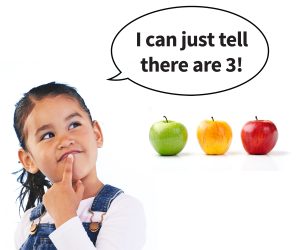 What Is Subitizing?
What Is Subitizing?
Subitizing, like counting, helps us answer the question “how many?” Subitizing is different because it involves knowing “how many” without counting each item in a set.
“Subitize” means “suddenly.” People “just see” or “just hear” exactly how many. Children perceive small quantities even before they learn number words. Many scientists view subitizing as an unlearned, intuitive ability in humans and other animals, and find that—in the most basic sense—subitizing is limited to small quantities, like one, two, three, and maybe four items. Other researchers and educators define perceptual subitizing as learning to assign number words to these intuitive quantities. They define conceptual subitizing, such as “seeing” six in two groups of three, as a way to quantify larger quantities.
Why Is Learning About Subitizing Important?
Subitizing is an important and often neglected foundation in math for two reasons:
First, teachers’ awareness of this intuitive ability helps them appreciate that all children are mathematical thinkers. Why? Because subitizing is the first way children experience quantities—from birth.
Second, many math skills build on children’s ability to subitize. Even counting skills benefit from children developing perceptual subitizing early. Conceptual subitizing is one important way to understand addition.
What Do Children Need to Know About Subitizing?
To build perceptual subitizing skills, children need to be able to connect their intuitive perception of specific small quantities to corresponding number words.
To extend perceptual subitizing to build conceptual subitizing, children need to be able to:
- Recognize larger quantities by seeing the smaller sets that make them up, and
- Quickly and implicitly combine the sets together into one quantity.